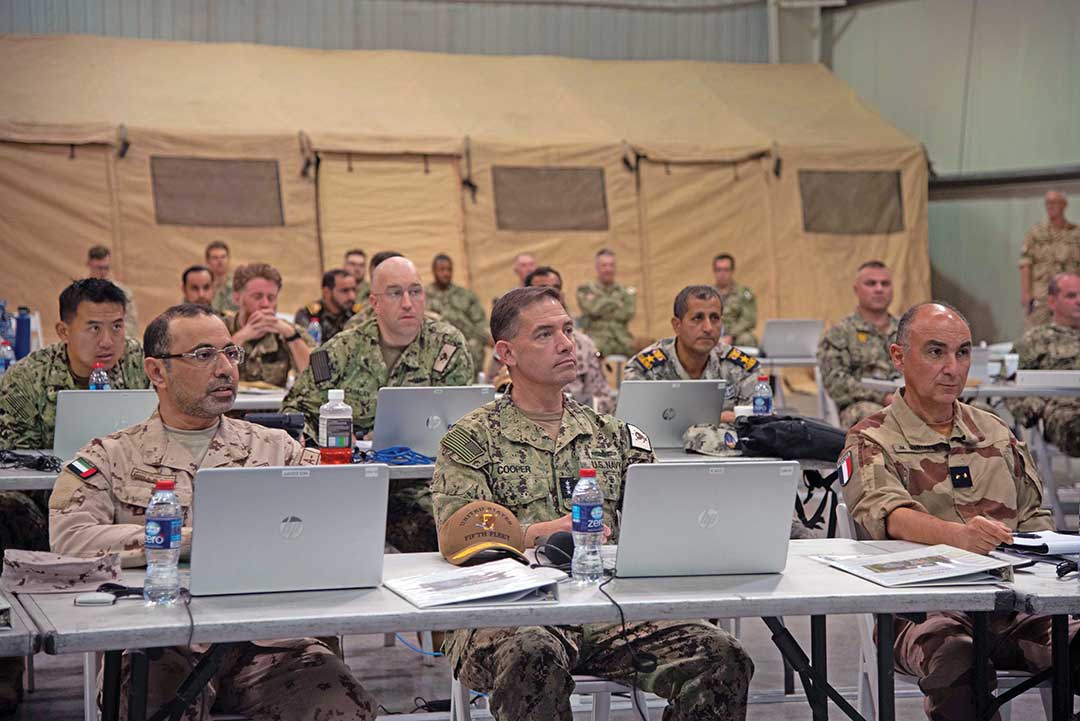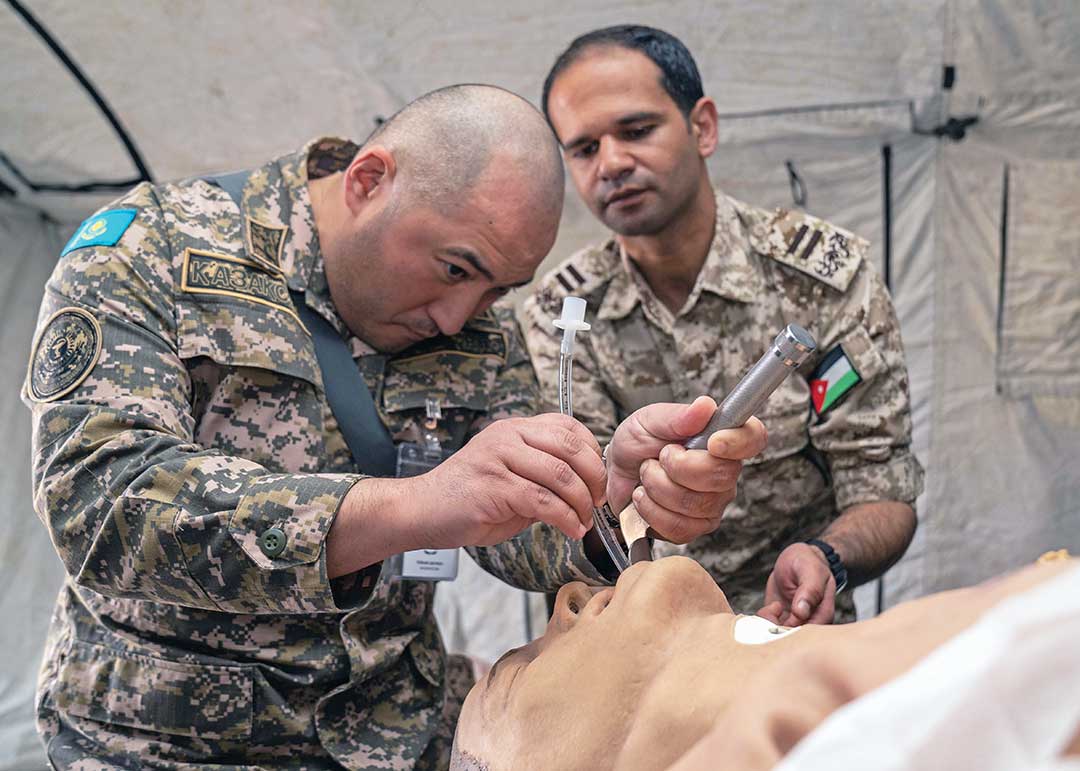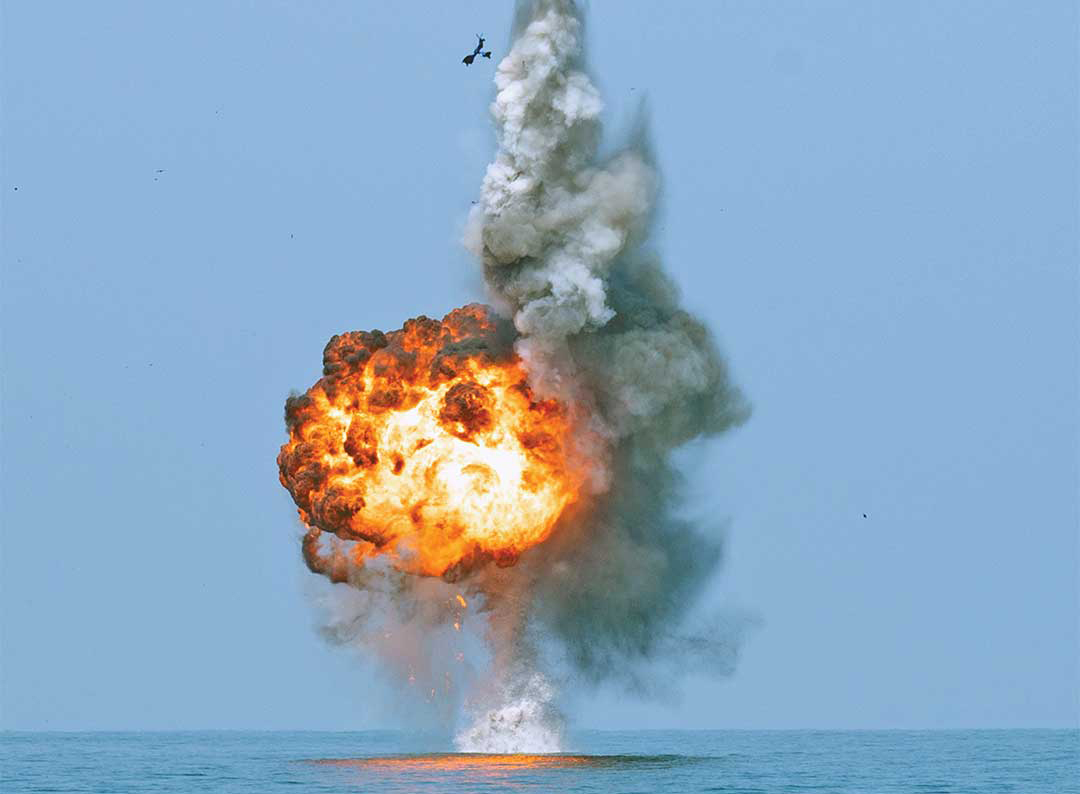Training Together for Safer Seas
The International Maritime Exercise demonstrates global resolve to keep shipping lanes open
UNIPATH STAFF
In a naval display stretching from the Arabian Gulf to the east coast of Africa and the northern Red Sea port of Aqaba to the Gulf of Oman, thousands of Sailors and Marines joined forces at the International Maritime Exercise (IMX) in March 2023.
Perennial conventional naval operations such as minesweeping, gunnery practice, and visit, board, search and seizure shaped the exercise scenarios. However, IMX has shifted much of its focus to automation. So great are the expanses of the seas — and so strategically important those waters — that unmanned systems and artificial intelligence have become critical tools to extend the range of navies and coast guards.
IMX deployed more than 30 unmanned and artificial intelligence systems on both sides of the Arabian Peninsula. Some hovered like propeller planes. Others spun from ship’s decks like miniature helicopters. Still others slid underwater like torpedoes or sped across the water like speedboats or coasted like sailboats.
In the Gulf of Aqaba, where Jordanian and U.S. forces have introduced aerial, underwater and surface drones to assist traditional fleets, IMX participants simulated evacuating injured sailors by strapping a mannequin to an unammned remotely controlled speedboat.
The U.S. and its partners also introduced a resilient unmanned aerial vehicle called the K1000ULE. Able to fly without pause for more than 26 hours, the drone served as a communication link with aquatic drones monitoring the seas below.
“This exercise was a good platform to have regional navies under one roof. We have different tactics and procedures, but we had one cause during the exercise of coordination, cooperation and interoperability,” said Pakistan Navy Lt. Cmdr. Najaf Rizvi.

In addition to testing unmanned systems in real-world conditions, the exercise concentrated on combined command and control, maritime security, mine countermeasures, seizure of illicit vessels and cargo and — in a nod to the COVID-19 pandemic — global health management.
IMX shared its 18-day run with a complementary East African maritime exercise called Cutlass Express. Participating international forces and organizations split into five operational task forces totaling 35 ships that spanned the Arabian Gulf, Arabian Sea, Gulf of Oman, Gulf of Aden, Red Sea, Indian Ocean and East African coastal regions.
Command and control of training missions resided with a Mission Operations Center at
U.S. 5th Fleet Headquarters in Manama, Bahrain. Multinational participants sat shoulder to shoulder at screens tracking the progress of commercial and military ships across regional waterways.
The control center in Manama included personnel from Bahrain, Egypt, Great Britain, Lebanon, Pakistani, Qatar, the United Arab Emirates, the United States and Yemen. The exercise enlisted multinational troops to staff multiple control centers.
U.S. Navy Vice Adm. Brad Cooper, commander of U.S. Navy Central, served as exercise commander. Fellow officers from the United Arab Emirates, France, Pakistan and Egypt served as deputy commander, vice commander, chief of staff and operations center director.
IMX’s five task forces, consisting of nearly 7,000 participants, were equally multinational. They were commanded by officers from Bahrain, Jordan, Saudi Arabia, Kenya and the United States.

SPC. AARON TROUTMAN/U.S. ARMY
“The incredible level of international representation is truly remarkable,” Vice Adm. Cooper said. “Maritime forces are always at our best when we work and lead together.”
Patrolling the seas for drug and weapons smuggling is a fact of life aboard naval and coast guard vessels serving in the waters surrounding the Arabian peninsula. IMX ensured it integrated these types of scenarios into the training events.
Multinational troops began their instruction in warehouses. They absorbed techniques and tactics in classroom lectures, practiced subduing suspects and conducted raids on shipping containers stacked to resemble the decks, cabins and cargo holds of ships in the U.S. Coast Guard’s Maritime Engagement Team training warehouse.
On the Bahrain naval base, Jordanians enrolled in one class, Emiratis, Singaporeans
and British in another, and Kazakhs, Azerbaijanis and Yemenis in a third.
As armed squads raced inside the mock-up of a ship, plastic bullets pinged off the sides of the shipping containers. Soldiers awaiting their turn observed the raid on a bank of 20 closed-circuit television screens that captured the action from different angles.
A full-scale Arabian dhow in the U.S. Coast Guard training warehouse allowed trainees to practice the search for and seizure of illicit cargo. For example, troops learned how to examine ship hulls for hidden compartments.

Once they gained proficiency on trial runs with the dhow and shipping containers, troops shifted to storming real ships afloat, actions that blended seamlessly into the IMX training scenario. U.S. Navy expeditionary sea base USS Lewis B. Puller, patrolling in the Arabian Gulf, played host to some of the teams, under the eyes of trainers from the U.S. Marine Corps and Coast Guard.
“I liked this gathering because it was international. Together we stand, divided we fall,” said Yemen Coast Guard Cmdr. Faozi Sultan, whose men trained in visit, board, search and seizure. “This exercise is of great importance for all the countries that participated because it was a chance to exchange experiences and learn from each other.”
IMX 23 succeeded in its goal of supporting the rules-based international order to ensure the free flow of commerce through some of the world’s busiest shipping lanes and to intercept vessels intent on violating those rules.
That security commitment continues year-round through the operations of the Combined Maritime Forces, the 34-nation naval coalition based in Bahrain. Its task forces — increasingly reinforced with the deployment of unmanned systems — provide security for the same waterways identified by IMX.
“I’ve learned a lot in the decision-making process, especially through multiple training situations that happened at the same time,” IMX participant Egyptian Navy Cmdr. Mohamed Gharbyia said. “It made me think outside the box.”


Comments are closed.